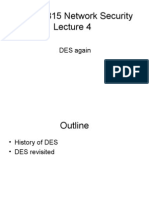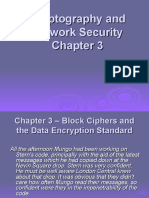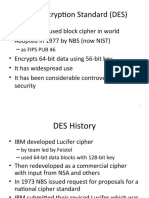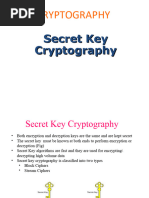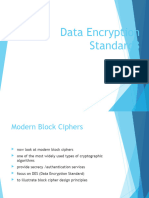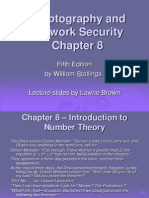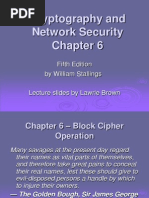0 ratings0% found this document useful (0 votes)
Block Ciphers and The Data Encryption Standard
Block Ciphers and The Data Encryption Standard
Uploaded by
iamthe11This document provides an overview of modern block ciphers and the Data Encryption Standard (DES) algorithm. It discusses how block ciphers like DES work by partitioning messages into blocks that are encrypted separately using a substitution-permutation network. DES encrypts 64-bit blocks using a 56-bit key and Feistel cipher structure. While DES was once widely used, advances in cryptanalysis have demonstrated weaknesses in its 56-bit key size and various attacks have been developed against its structure, like differential and linear cryptanalysis. More rounds and larger keys are now recommended for modern block ciphers.
Copyright:
© All Rights Reserved
Available Formats
Download as PPT, PDF, TXT or read online from Scribd
Download as ppt, pdf, or txt
Block Ciphers and The Data Encryption Standard
Block Ciphers and The Data Encryption Standard
Uploaded by
iamthe110 ratings0% found this document useful (0 votes)
This document provides an overview of modern block ciphers and the Data Encryption Standard (DES) algorithm. It discusses how block ciphers like DES work by partitioning messages into blocks that are encrypted separately using a substitution-permutation network. DES encrypts 64-bit blocks using a 56-bit key and Feistel cipher structure. While DES was once widely used, advances in cryptanalysis have demonstrated weaknesses in its 56-bit key size and various attacks have been developed against its structure, like differential and linear cryptanalysis. More rounds and larger keys are now recommended for modern block ciphers.
Original Description:
Chapter 3
Original Title
ch03
Copyright
© © All Rights Reserved
Available Formats
PPT, PDF, TXT or read online from Scribd
Share this document
Did you find this document useful?
Is this content inappropriate?
This document provides an overview of modern block ciphers and the Data Encryption Standard (DES) algorithm. It discusses how block ciphers like DES work by partitioning messages into blocks that are encrypted separately using a substitution-permutation network. DES encrypts 64-bit blocks using a 56-bit key and Feistel cipher structure. While DES was once widely used, advances in cryptanalysis have demonstrated weaknesses in its 56-bit key size and various attacks have been developed against its structure, like differential and linear cryptanalysis. More rounds and larger keys are now recommended for modern block ciphers.
Copyright:
© All Rights Reserved
Available Formats
Download as PPT, PDF, TXT or read online from Scribd
Download as ppt, pdf, or txt
0 ratings0% found this document useful (0 votes)
Block Ciphers and The Data Encryption Standard
Block Ciphers and The Data Encryption Standard
Uploaded by
iamthe11This document provides an overview of modern block ciphers and the Data Encryption Standard (DES) algorithm. It discusses how block ciphers like DES work by partitioning messages into blocks that are encrypted separately using a substitution-permutation network. DES encrypts 64-bit blocks using a 56-bit key and Feistel cipher structure. While DES was once widely used, advances in cryptanalysis have demonstrated weaknesses in its 56-bit key size and various attacks have been developed against its structure, like differential and linear cryptanalysis. More rounds and larger keys are now recommended for modern block ciphers.
Copyright:
© All Rights Reserved
Available Formats
Download as PPT, PDF, TXT or read online from Scribd
Download as ppt, pdf, or txt
You are on page 1/ 54
Chapter 3 Block Ciphers and the
Data Encryption Standard
Last Chapter
have considered:
terminology
classical cipher techniques
substitution ciphers
cryptanalysis using letter frequencies
transposition ciphers
Modern Block Ciphers
will now look at modern block ciphers
one of the most widely used types of
cryptography algorithms
provide strong secrecy and/or
authentication services
in particular will introduce DES (Data
Encryption Standard)
Block vs Stream Ciphers
block ciphers process messages into
blocks, each of which is then en/decrypted
like a substitution on very big characters
64-bits or more
stream ciphers process messages a bit or
byte at a time when en/decrypting
many current ciphers are block ciphers
hence are focus of course
Block Cipher Principles
block ciphers look like an extremely large
substitution
would need table of 2
64
entries for a 64-bit block
arbitrary reversible substitution cipher for a large
block size is not practical
64-bit general substitution block cipher, key size 2
64
!
most symmetric block ciphers are based on a
Feistel Cipher Structure
needed since must be able to decrypt ciphertext
to recover messages efficiently
C. Shannon and Substitution-
Permutation Ciphers
in 1949 Shannon introduced idea of substitution-
permutation (S-P) networks
modern substitution-transposition product cipher
these form the basis of modern block ciphers
S-P networks are based on the two primitive
cryptographic operations we have seen before:
substitution (S-box)
permutation (P-box) (transposition)
provide confusion and diffusion of message
Diffusion and Confusion
Introduced by Claude Shannon to thwart
cryptanalysis based on statistical analysis
Assume the attacker has some knowledge of
the statistical characteristics of the plaintext
cipher needs to completely obscure
statistical properties of original message
a one-time pad does this
Diffusion and Confusion
more practically Shannon suggested
combining elements to obtain:
diffusion dissipates statistical structure
of plaintext over bulk of ciphertext
confusion makes relationship between
ciphertext and key as complex as possible
Feistel Cipher Structure
Horst Feistel devised the feistel cipher
implements Shannons substitution-
permutation network concept
partitions input block into two halves
process through multiple rounds which
perform a substitution on left data half
based on round function of right half & subkey
then have permutation swapping halves
Feistel Cipher Structure
Feistel Cipher
n sequential rounds
A substitution on the left half L
i
1. Apply a round function F to the right half R
i
and
2. Take XOR of the output of (1) and L
i
The round function is parameterized by
the subkey K
i
K
i
are derived from the overall key K
Feistel Cipher Design Principles
block size
increasing size improves security, but slows cipher
key size
increasing size improves security, makes exhaustive key
searching harder, but may slow cipher
number of rounds
increasing number improves security, but slows cipher
subkey generation
greater complexity can make analysis harder, but slows cipher
round function
greater complexity can make analysis harder, but slows cipher
fast software en/decryption & ease of analysis
are more recent concerns for practical use and testing
Feistel Cipher Decryption
Data Encryption Standard (DES)
most widely used block cipher in world
adopted in 1977 by NBS (now NIST)
as FIPS PUB 46
encrypts 64-bit data using 56-bit key
has widespread use
DES History
IBM developed Lucifer cipher
by team led by Feistel
used 64-bit data blocks with 128-bit key
then redeveloped as a commercial cipher
with input from NSA and others
in 1973 NBS issued request for proposals
for a national cipher standard
IBM submitted their revised Lucifer which
was eventually accepted as the DES
DES Design Controversy
although DES standard is public
was considerable controversy over design
in choice of 56-bit key (vs Lucifer 128-bit)
subsequent events and public analysis
show in fact design was appropriate
DES has become widely used, especially
in financial applications
DES Encryption
Initial Permutation IP
first step of the data computation
IP reorders the input data bits
quite regular in structure
see text Table 3.2
example:
IP(675a6967 5e5a6b5a) = (ffb2194d 004df6fb)
DES Round Structure
uses two 32-bit L & R halves
as for any Feistel cipher can describe as:
L
i
= R
i1
R
i
= L
i1
xor F(R
i1
, K
i
)
takes 32-bit R half and 48-bit subkey and:
expands R to 48-bits using Expansion Permutation E
(Table 3.2 c.)
adds to subkey
passes through 8 S-boxes to get 32-bit result
finally permutes this using 32-bit Permutation
Function P (Table 3.2 d)
The round function F(R,K)
Substitution Boxes S
8 S-boxes (Table 3.3 )
Each S-Box mapps 6 to 4 bits
outer bits 1 & 6 (row bits) select the row
inner bits 2-5 (col bits) select the column
For example, in S1, for input 011001,
the row is 01 (row 1)
the column is 1100 (column 12).
The value in row 1, column 12 is 9
The output is 1001.
result is 8 X 4 bits, or 32 bits
DES Key Schedule
forms subkeys used in each round
1. initial permutation of the key PC1 (Table 3.4b)
2. divide the 56-bits in two 28-bit halves
3. at each round
3.1. Left shift each half (28bits) separately either 1 or
2 places based on the left shift schedule (Table 3.4d)
Shifted values will be input for next round
3.2. Combine two halfs to 56 bits, permuting them by
PC2 (Table 3.4c) for use in function f
PC2 takes 56-bit input, outputs 48 bits
DES Decryption
decrypt must unwind steps of data computation
with Feistel design, do encryption steps again
using subkeys in reverse order (SK16 SK1)
note that IP undoes final FP step of encryption
1st round with SK16 undoes 16th encrypt round
.
16th round with SK1 undoes 1st encrypt round
then final FP undoes initial encryption IP
thus recovering original data value
DES Decryption (reverse
encryption)
Avalanche Effect
key desirable property of encryption alg
DES exhibits strong avalanche
where a change of one input or key bit
results in changing approx half output bits
Strength of DES Key Size
56-bit keys have 2
56
= 7.2 x 10
16
values
brute force search looks hard
recent advances have shown is possible
in 1997 on Internet in a few months
in 1998 on dedicated hardware (EFF) in a few
days
in 1999 above combined in 22hrs!
still must be able to recognize plaintext
now considering alternatives to DES
Strength of DES Timing Attacks
attacks actual implementation of cipher
use knowledge of consequences of
implementation to derive knowledge of
some/all subkey bits
specifically use fact that calculations can
take varying times depending on the value
of the inputs to it
Strength of DES Analytic Attacks
now have several analytic attacks on DES
these utilise some deep structure of the cipher
by gathering information about encryptions
can eventually recover some/all of the sub-key bits
if necessary then exhaustively search for the rest
generally these are statistical attacks
include
differential cryptanalysis
linear cryptanalysis
related key attacks
Differential Cryptanalysis
one of the most significant recent (public)
advances in cryptanalysis
known in 70's with DES design
Murphy, Biham & Shamir published 1990
powerful method to analyse block ciphers
used to analyse most current block ciphers
with varying degrees of success
DES reasonably resistant to it
Differential Cryptanalysis
a statistical attack against Feistel ciphers
uses cipher structure not previously used
design of S-P networks has output of
function f influenced by both input & key
hence cannot trace values back through
cipher without knowing values of the key
Differential Cryptanalysis compares two
related pairs of encryptions
Differential Cryptanalysis
Compares Pairs of Encryptions
Differential cryptanalysis is complex
with a known difference in the input
searching for a known difference in output
Differential Cryptanalysis
have some input difference giving some
output difference with probability p
if find instances of some higher probability
input / output difference pairs occurring
can infer subkey that was used in round
then must iterate process over many
rounds
Differential Cryptanalysis
perform attack by repeatedly encrypting plaintext pairs
with known input XOR until obtain desired output XOR
when found
if intermediate rounds match required XOR have a right pair
if not then have a wrong pair
can then deduce keys values for the rounds
right pairs suggest same key bits
wrong pairs give random values
larger numbers of rounds makes it more difficult
Attack on full DES requires an effort on the order of 2
47
,
requiring 2
47
chosen plaintexts to be encrypted
Linear Cryptanalysis
another recent development
also a statistical method
based on finding linear approximations to
model the transformation of DES
can attack DES with 2
47
known plaintexts,
still in practise infeasible
Criteria for S-Boxes
No output of any S-Box is too close to a linear
function of the input bits
Each row of an S-Box includes all 16 possible
output bit combinations
If two inputs to an S-box differ in one bit, the
output bits differ in at least two bits
If two inputs differ is the two middle bits, outputs
must differ at least two bits
Defend against differential analysis and provide
good confusion properties
Block Cipher Design Principles
basic principles still like Feistel in 1970s
number of rounds
more is better, makes exhaustive search best
attack
16 rounds: brute force 2
55
differential analysis: 2
55.1
Block Cipher Design Principles
function F:
provides confusion, is nonlinear, avalanche
Strict Avalanche Criterion (SAC)
Any output bit i should change with p=1/2 when
any single input bit j is inverted, for all i,j
Applies to both S-Boxes and the overall F function
key schedule
No general rule has been discovered
complex subkey creation, key avalanche
Modes of Operation
block ciphers encrypt fixed size blocks
eg. DES encrypts 64-bit blocks, with 56-bit key
need way to use in practise, given usually have
arbitrary amount of information to encrypt
four were defined for DES in ANSI standard
ANSI X3.106-1983 Modes of Use
DES is the basic building block
have block and stream modes
Electronic Codebook Book (ECB)
message is broken into independent blocks
which are encrypted
each block is a value which is substituted, like a
codebook, hence name
Each DES is a very complex 64-bit to 64-bit
substitution
each block is encoded independently of the
other blocks
C
i
= DES
K1
(P
i
)
uses: secure transmission of single values
Repeated input blocks have same output
Not secure for long transmission
Electronic Codebook Book (ECB)
Advantages and Limitations of ECB
repetitions in message may show in
ciphertext
if aligned with message block
particularly with data such graphics
or with messages that change very little,
which become a code-book analysis problem
weakness due to encrypted message
blocks being independent
main use is sending a few blocks of data
Cipher Block Chaining (CBC)
message is broken into blocks
but these are linked together in the
encryption operation
each previous cipher blocks is chained
with current plaintext block, hence name
use Initial Vector (IV) to start process
C
i
= DES
K1
(P
i
XOR C
i-1
)
C
-1
= IV
uses: bulk data encryption, authentication
Cipher Block Chaining (CBC)
Advantages and Limitations of CBC
each ciphertext block depends on all message blocks
thus a change in the message affects all ciphertext
blocks after the change as well as the original block
need Initial Value (IV) known to sender & receiver
however if IV is sent in the clear, an attacker can
change bits of the first block, and change IV to
compensate
hence either IV must be a fixed value (as in EFTPOS)
or it must be sent encrypted in ECB mode before rest
of message
Cipher FeedBack (CFB)
message is treated as a stream of bits
added to the output of the block cipher
result is feed back for next stage (hence name)
standard allows any number of bit (1,8 or 64 or
whatever) to be feed back
denoted CFB-1, CFB-8, CFB-64 etc
is most efficient to use all 64 bits (CFB-64)
C
i
= P
i
XOR DES
K1
(C
i-1
)
C
-1
= IV
uses: stream data encryption, authentication
Cipher FeedBack (CFB)
Advantages and Limitations of CFB
appropriate when data arrives in bits/bytes
most common stream mode
note that the block cipher is used in
encryption mode at both ends
errors propagate for several blocks after
the error
Must use over a reliable network channel
Output FeedBack (OFB)
message is treated as a stream of bits
output of cipher is added to message
output is then feed back (hence name)
feedback is independent of message
can be computed in advance
C
i
= P
i
XOR O
i
O
i
= DES
K1
(O
i-1
)
O
-1
= IV
uses: stream encryption over noisy channels
Output FeedBack (OFB)
Advantages and Limitations of OFB
used when error feedback a problem or where need to
encryptions before message is available
superficially similar to CFB
but feedback is from the output of cipher and is
independent of message
Errors do not propagate
sender and receiver must remain in sync, and some
recovery method is needed to ensure this occurs
Because the "random" bits are independent of the
message, they must never be used more than once
otherwise the 2 ciphertexts can be combined, cancelling these
bits)
Counter (CTR)
a new mode, though proposed early on
encrypts counter value rather than any
feedback value
must have a different key & counter value
for every plaintext block (never reused)
C
i
= P
i
XOR O
i
O
i
= DES
K1
(i)
uses: high-speed network encryptions
Counter (CTR)
Advantages and Limitations of CTR
efficiency
can do parallel encryptions
in advance of need
good for bursty high speed links
random access to encrypted data blocks
Do not have to decode from the beginning
provable security (good as other modes)
but must ensure never reuse key/counter
values, otherwise could break (cf OFB)
Summary
have considered:
block cipher design principles
DES
details
strength
Differential & Linear Cryptanalysis
Modes of Operation
ECB, CBC, CFB, OFB, CTR
You might also like
- Chapter 3 - Block Ciphers and The Data Encryption StandardNo ratings yetChapter 3 - Block Ciphers and The Data Encryption Standard34 pages
- Block Ciphers and The Data Encryption Standard: DraksahooNo ratings yetBlock Ciphers and The Data Encryption Standard: Draksahoo60 pages
- Chapter 3 - Block Ciphers and The Data Encryption StandardNo ratings yetChapter 3 - Block Ciphers and The Data Encryption Standard47 pages
- Chapter 3 - Block Ciphers and The Data Encryption StandardNo ratings yetChapter 3 - Block Ciphers and The Data Encryption Standard47 pages
- Cryptography and Network Security - Chap 4No ratings yetCryptography and Network Security - Chap 445 pages
- Symmetric Encryption Algorithms: CS-480b Dick SteflikNo ratings yetSymmetric Encryption Algorithms: CS-480b Dick Steflik40 pages
- Block Ciphers (DES) : Fourth Edition by William StallingsNo ratings yetBlock Ciphers (DES) : Fourth Edition by William Stallings20 pages
- William Stallings, Cryptography and Network Security 3 - eNo ratings yetWilliam Stallings, Cryptography and Network Security 3 - e42 pages
- Cryptography and Network Security Unit - 2 Chapter 3 - Block Ciphers and The Data Encryption StandardNo ratings yetCryptography and Network Security Unit - 2 Chapter 3 - Block Ciphers and The Data Encryption Standard86 pages
- Chapter 2 (B) - Block Ciphers and Data Encryption StandardNo ratings yetChapter 2 (B) - Block Ciphers and Data Encryption Standard36 pages
- Unit II Symmetric Ciphers: Prepared By: Suresh Thapa Vedas College, Jawalakhel, LalitpurNo ratings yetUnit II Symmetric Ciphers: Prepared By: Suresh Thapa Vedas College, Jawalakhel, Lalitpur89 pages
- Cryptography and Network Security UNIT-2No ratings yetCryptography and Network Security UNIT-238 pages
- FALLSEM2023-24_CSI3022_ETH_VL2023240104364_2023-08-25_Reference-Material-INo ratings yetFALLSEM2023-24_CSI3022_ETH_VL2023240104364_2023-08-25_Reference-Material-I37 pages
- Cryptography and Network Security: Fourth Edition by William StallingsNo ratings yetCryptography and Network Security: Fourth Edition by William Stallings37 pages
- Network Security Essentials: Fourth Edition by William Stallings Lecture Slides by Lawrie BrownNo ratings yetNetwork Security Essentials: Fourth Edition by William Stallings Lecture Slides by Lawrie Brown46 pages
- Block Ciphers and The Data Encryption StandardNo ratings yetBlock Ciphers and The Data Encryption Standard38 pages
- Based On: Cryptography and Network Security: Third Edition by William Stallings Lecture Slides by Lawrie BrownNo ratings yetBased On: Cryptography and Network Security: Third Edition by William Stallings Lecture Slides by Lawrie Brown92 pages
- 15 Oct Symmetric-Key-Encryption-AlgorithmsNo ratings yet15 Oct Symmetric-Key-Encryption-Algorithms64 pages
- Lecture 3 Data Encryption Standard (DES) and Advanced Encrption StandardNo ratings yetLecture 3 Data Encryption Standard (DES) and Advanced Encrption Standard62 pages
- Information Security CSD-410: Computer Science and Engineering Department National Institute of TechnologyNo ratings yetInformation Security CSD-410: Computer Science and Engineering Department National Institute of Technology28 pages
- Echo on a Chip - Secure Embedded Systems in Cryptography: A New Perception for the Next Generation of Micro-Controllers handling Encryption for Mobile MessagingFrom EverandEcho on a Chip - Secure Embedded Systems in Cryptography: A New Perception for the Next Generation of Micro-Controllers handling Encryption for Mobile MessagingNo ratings yet
- Internet Security: Cryptographic Principles, Algorithms and ProtocolsFrom EverandInternet Security: Cryptographic Principles, Algorithms and ProtocolsNo ratings yet
- Cisco Packet Tracer Implementation: Building and Configuring Networks: 1, #1From EverandCisco Packet Tracer Implementation: Building and Configuring Networks: 1, #1No ratings yet
- Cryptography and Network Security: Fifth Edition by William StallingsNo ratings yetCryptography and Network Security: Fifth Edition by William Stallings28 pages
- Cryptography and Network Security: Third Edition by William StallingsNo ratings yetCryptography and Network Security: Third Edition by William Stallings39 pages
- Cryptography and Network Security: Fifth Edition by William StallingsNo ratings yetCryptography and Network Security: Fifth Edition by William Stallings36 pages
- Cryptography and Network Security: Fifth Edition by William StallingsNo ratings yetCryptography and Network Security: Fifth Edition by William Stallings35 pages
- Cryptography and Network Security: Fifth Edition by William StallingsNo ratings yetCryptography and Network Security: Fifth Edition by William Stallings20 pages
- A Format-Preserving Encryption FF1, FF3-1 Using Lightweight Block Ciphers LEA And, SPECKNo ratings yetA Format-Preserving Encryption FF1, FF3-1 Using Lightweight Block Ciphers LEA And, SPECK7 pages
- 13-Modes of Operation of Block Ciphers-03!02!2024No ratings yet13-Modes of Operation of Block Ciphers-03!02!202413 pages
- Cryptography and Network Security Chapter 2No ratings yetCryptography and Network Security Chapter 215 pages
- VTU Network Security (10ec832) Unit-2 Notes..100% (3)VTU Network Security (10ec832) Unit-2 Notes..91 pages
- Enhancing The Data Security of Simple Columnar Transposition Cipher by Caesar Cipher and Rail Fence Cipher Technique.No ratings yetEnhancing The Data Security of Simple Columnar Transposition Cipher by Caesar Cipher and Rail Fence Cipher Technique.8 pages
- Chapter 3 - Block Ciphers and The Data Encryption StandardChapter 3 - Block Ciphers and The Data Encryption Standard
- Block Ciphers and The Data Encryption Standard: DraksahooBlock Ciphers and The Data Encryption Standard: Draksahoo
- Chapter 3 - Block Ciphers and The Data Encryption StandardChapter 3 - Block Ciphers and The Data Encryption Standard
- Chapter 3 - Block Ciphers and The Data Encryption StandardChapter 3 - Block Ciphers and The Data Encryption Standard
- Symmetric Encryption Algorithms: CS-480b Dick SteflikSymmetric Encryption Algorithms: CS-480b Dick Steflik
- Block Ciphers (DES) : Fourth Edition by William StallingsBlock Ciphers (DES) : Fourth Edition by William Stallings
- William Stallings, Cryptography and Network Security 3 - eWilliam Stallings, Cryptography and Network Security 3 - e
- Cryptography and Network Security Unit - 2 Chapter 3 - Block Ciphers and The Data Encryption StandardCryptography and Network Security Unit - 2 Chapter 3 - Block Ciphers and The Data Encryption Standard
- Chapter 2 (B) - Block Ciphers and Data Encryption StandardChapter 2 (B) - Block Ciphers and Data Encryption Standard
- Unit II Symmetric Ciphers: Prepared By: Suresh Thapa Vedas College, Jawalakhel, LalitpurUnit II Symmetric Ciphers: Prepared By: Suresh Thapa Vedas College, Jawalakhel, Lalitpur
- FALLSEM2023-24_CSI3022_ETH_VL2023240104364_2023-08-25_Reference-Material-IFALLSEM2023-24_CSI3022_ETH_VL2023240104364_2023-08-25_Reference-Material-I
- Cryptography and Network Security: Fourth Edition by William StallingsCryptography and Network Security: Fourth Edition by William Stallings
- Network Security Essentials: Fourth Edition by William Stallings Lecture Slides by Lawrie BrownNetwork Security Essentials: Fourth Edition by William Stallings Lecture Slides by Lawrie Brown
- Based On: Cryptography and Network Security: Third Edition by William Stallings Lecture Slides by Lawrie BrownBased On: Cryptography and Network Security: Third Edition by William Stallings Lecture Slides by Lawrie Brown
- Lecture 3 Data Encryption Standard (DES) and Advanced Encrption StandardLecture 3 Data Encryption Standard (DES) and Advanced Encrption Standard
- Information Security CSD-410: Computer Science and Engineering Department National Institute of TechnologyInformation Security CSD-410: Computer Science and Engineering Department National Institute of Technology
- Application and Implementation of DES Algorithm Based on FPGAFrom EverandApplication and Implementation of DES Algorithm Based on FPGA
- Blowfish Cipher Tutorials - Herong's Tutorial ExamplesFrom EverandBlowfish Cipher Tutorials - Herong's Tutorial Examples
- Echo on a Chip - Secure Embedded Systems in Cryptography: A New Perception for the Next Generation of Micro-Controllers handling Encryption for Mobile MessagingFrom EverandEcho on a Chip - Secure Embedded Systems in Cryptography: A New Perception for the Next Generation of Micro-Controllers handling Encryption for Mobile Messaging
- C# Package Mastery: 100 Essentials in 1 Hour - 2024 EditionFrom EverandC# Package Mastery: 100 Essentials in 1 Hour - 2024 Edition
- Internet Security: Cryptographic Principles, Algorithms and ProtocolsFrom EverandInternet Security: Cryptographic Principles, Algorithms and Protocols
- Cisco Packet Tracer Implementation: Building and Configuring Networks: 1, #1From EverandCisco Packet Tracer Implementation: Building and Configuring Networks: 1, #1
- Cryptography and Network Security: Fifth Edition by William StallingsCryptography and Network Security: Fifth Edition by William Stallings
- Cryptography and Network Security: Third Edition by William StallingsCryptography and Network Security: Third Edition by William Stallings
- Cryptography and Network Security: Fifth Edition by William StallingsCryptography and Network Security: Fifth Edition by William Stallings
- Cryptography and Network Security: Fifth Edition by William StallingsCryptography and Network Security: Fifth Edition by William Stallings
- Cryptography and Network Security: Fifth Edition by William StallingsCryptography and Network Security: Fifth Edition by William Stallings
- A Format-Preserving Encryption FF1, FF3-1 Using Lightweight Block Ciphers LEA And, SPECKA Format-Preserving Encryption FF1, FF3-1 Using Lightweight Block Ciphers LEA And, SPECK
- Enhancing The Data Security of Simple Columnar Transposition Cipher by Caesar Cipher and Rail Fence Cipher Technique.Enhancing The Data Security of Simple Columnar Transposition Cipher by Caesar Cipher and Rail Fence Cipher Technique.








